Late blight caused by the fungus Phytophthora infestans is the most
important disease of potato that can result into crop
failures in a short period if appropriate control
measures are not adopted. Losses in potato yield can
go as high as 80% in epidemic years. During past
years, epidemics of the disease have appeared in
1985-86, 1989-90, 1992-93, 1997-98, 2006-07 and
recently during 2007-08 season.
Distribution in State
Late
blight occurs frequently in the districts of
Hoshiarpur, Jalandhar, Nawan Shehar, Kapurthala, Ropar
and Amritsar. Hoshiarpur is generally considered to be
the hot spot for this disease. The disease is
generally observed first in certain pockets of
district Hoshiarpur like Sham Chaurasi, Mehtiana,
Phuglana and areas around Tanda and spreads further to
adjoining regions under favourable weather conditions.
In the districts like Ludhiana, Patiala, Fatehgarh Sahib, Moga
and Sangrur, the disease is noticed in moderate
incidence and does not appear every year or develops
late in the season. South-western districts such as
Bathinda, Faridkot and Ferozepur mainly remain free
from the disease or its attack is observed very rarely
during prolonged epidemic years only. Based on
prevalence of the disease in different regions
recorded over the past years, a late blight map for
Punjab has been prepared. Normally, early sown crop,
planted in early September and harvested in
mid-November for table purpose, escapes attack of the
disease because of high temperature prevailing during
this period or may be affected slightly at the end
without causing any significant damage.
Potato Cropping
Period and Late Blight favourable Period
Symptoms of Late Blight
On leaves:

Potato Leaf
Showing late blight Symptoms |
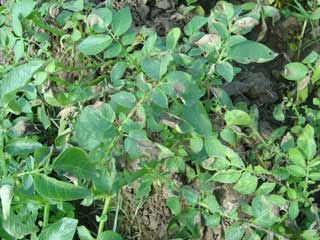
Potato foliage
affected by late blight |
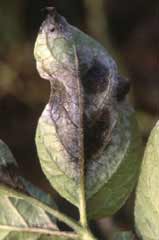
Sporulation of
P.infestans on lower leaf
surface |
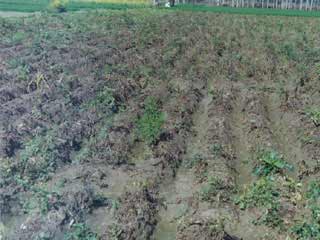
Potato field
affected by late blight |
On Stem:

Late blight symptoms on potato stem |
On Tubers
-
Infected tubers show irregular, shallow or sunken
reddish brown patches. Inside infected tissue is spongy
and rusty brown to varying depths. In sub-mountainous
areas, the lesions on tubers are locally called "Pathar
Dag". Later on, these lesions are often invaded by
secondary pathogens especially in wet soils or in
storage resulting into soft rot.
Late blight symptoms on potato tubers
Late
blight on spring crop
In
spring crop, which is planted in January, sprouts are
attacked at very young stage as the inoculum of the
fungus is readily available from the already infected
main season crop. Under such conditions, young leaves
and stems near the growing points are infected by the
fungal spores called sporangia. Brown necrosis is
evident around growing points. Ultimately whole of the
young sprouts are killed causing almost complete loss in
the yield.
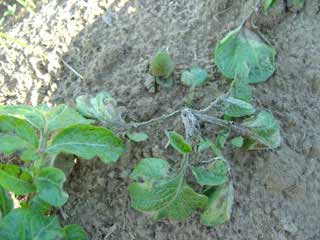
Young potato plant attacked by late blight |
Disease source, development and spread
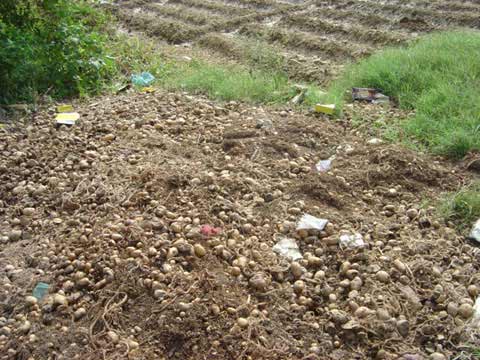
Diseased tubers piled up near potato field
For late sown or
spring crop or where successive crops are grown, the
previous infected crop often serve as the major source
of huge primary inoculum.
Disease cycle
Disease Cycle of Late Blight of Potato in Punjab
Races of Phytophthora infestans
Presently,
there are multigene complex races of P.infestans
on Potato in Punjab. Commonly occurring races in the State
are:
-
1.2.3.4.5.7.10.11
-
1.2.3.4.7.10.11
-
1.2.3.4.5.7.11
Sporangia of P. infestans